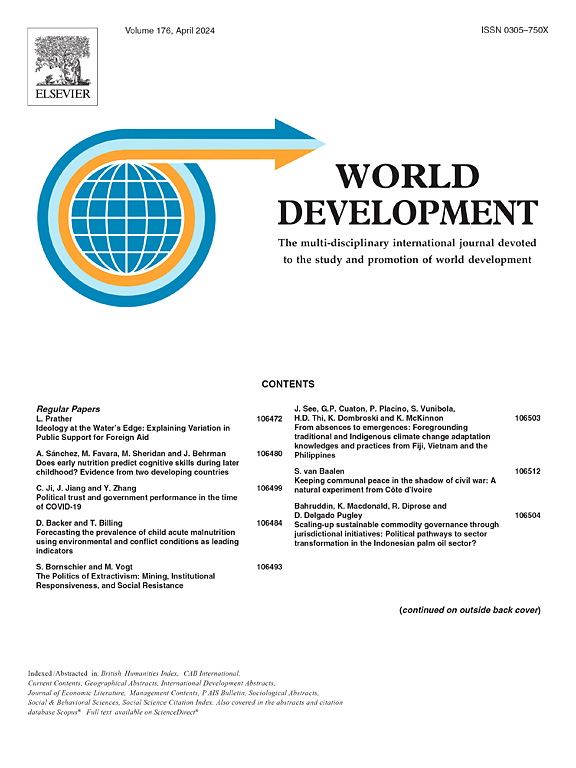The curse of television: Evidence from nutritional outcomes in rural China
IF 5.4
1区 经济学
Q1 DEVELOPMENT STUDIES
引用次数: 0
Abstract
Nutrition transition has been extensively studied worldwide, yet the potential role of mass media in facilitating this transition remains underexplored, despite its significance as the primary medium for disseminating information in past decades. Using the panel data from the China Health and Nutrition Survey (CHNS) from 2004 to 2015, this study investigates the causal effect of TV exposure on nutritional outcomes in rural China and explores the underlying mechanisms. Three aspects of TV exposure are considered: viewing time, program exposure, and advertisement exposure. Our results indicate that TV exposure has a significantly positive effect on the probability of being overweight and obese, regardless of which measurement of TV exposure is considered. This effect is particularly pronounced among males, individuals with lower education levels, those of Han ethnicity, and those who live in high-income households or undeveloped regions. Regarding the underlying mechanisms, we do not observe a significant effect of TV exposure on dietary knowledge, dietary quality (measured by the Dietary Balance Index and Chinese Healthy Eating Index), and exercise time. However, there is a significant positive effect on the consumption of unhealthy foods (including snacks and sugar-sweetened beverages) and increased nutrient intake (including energy, carbohydrate, fat, and protein). Given the adverse health implications associated with TV exposure, it is crucial to consider both traditional broadcast media and emerging information technologies in the development of policies aimed at improving nutritional health from a public health perspective.
电视的诅咒:来自中国农村营养状况的证据
营养转变在世界范围内得到了广泛的研究,然而,大众媒体在促进这一转变方面的潜在作用仍未得到充分探讨,尽管它在过去几十年中作为传播信息的主要媒介具有重要意义。本研究利用2004 - 2015年中国健康与营养调查(CHNS)的面板数据,调查了电视暴露对中国农村营养状况的因果关系,并探讨了其潜在机制。电视曝光涉及三个方面:观看时间、节目曝光和广告曝光。我们的研究结果表明,电视暴露对超重和肥胖的概率有显著的积极影响,无论考虑哪种电视暴露测量。这种影响在男性、受教育程度较低的个体、汉族以及生活在高收入家庭或不发达地区的人群中尤为明显。至于潜在的机制,我们没有观察到电视暴露对饮食知识、饮食质量(以饮食平衡指数和中国健康饮食指数衡量)和运动时间的显著影响。然而,对不健康食品(包括零食和含糖饮料)的消费和营养摄入(包括能量、碳水化合物、脂肪和蛋白质)的增加有显著的积极影响。鉴于与电视接触有关的不良健康影响,在制定旨在从公共卫生角度改善营养健康的政策时,必须同时考虑传统广播媒体和新兴信息技术。
本文章由计算机程序翻译,如有差异,请以英文原文为准。
求助全文
约1分钟内获得全文
求助全文
来源期刊

World Development
Multiple-
CiteScore
12.70
自引率
5.80%
发文量
320
期刊介绍:
World Development is a multi-disciplinary monthly journal of development studies. It seeks to explore ways of improving standards of living, and the human condition generally, by examining potential solutions to problems such as: poverty, unemployment, malnutrition, disease, lack of shelter, environmental degradation, inadequate scientific and technological resources, trade and payments imbalances, international debt, gender and ethnic discrimination, militarism and civil conflict, and lack of popular participation in economic and political life. Contributions offer constructive ideas and analysis, and highlight the lessons to be learned from the experiences of different nations, societies, and economies.
 求助内容:
求助内容: 应助结果提醒方式:
应助结果提醒方式:


